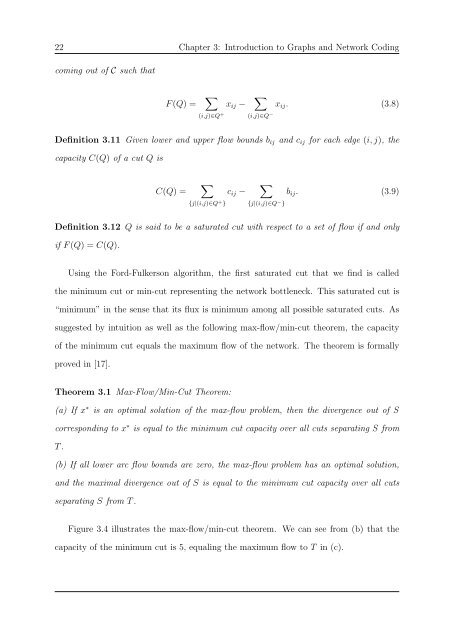Network Coding and Wireless Physical-layer ... - Jacobs University
Network Coding and Wireless Physical-layer ... - Jacobs University
Network Coding and Wireless Physical-layer ... - Jacobs University
You also want an ePaper? Increase the reach of your titles
YUMPU automatically turns print PDFs into web optimized ePapers that Google loves.
22 Chapter 3: Introduction to Graphs <strong>and</strong> <strong>Network</strong> <strong>Coding</strong><br />
coming out of C such that<br />
F (Q) =<br />
∑<br />
x ij −<br />
∑<br />
x ij . (3.8)<br />
(i,j)∈Q + (i,j)∈Q −<br />
Definition 3.11 Given lower <strong>and</strong> upper flow bounds b ij <strong>and</strong> c ij for each edge (i, j), the<br />
capacity C(Q) of a cut Q is<br />
∑<br />
C(Q) = c ij −<br />
∑<br />
b ij . (3.9)<br />
{j|(i,j)∈Q + } {j|(i,j)∈Q − }<br />
Definition 3.12 Q is said to be a saturated cut with respect to a set of flow if <strong>and</strong> only<br />
if F (Q) = C(Q).<br />
Using the Ford-Fulkerson algorithm, the first saturated cut that we find is called<br />
the minimum cut or min-cut representing the network bottleneck. This saturated cut is<br />
“minimum” in the sense that its flux is minimum among all possible saturated cuts. As<br />
suggested by intuition as well as the following max-flow/min-cut theorem, the capacity<br />
of the minimum cut equals the maximum flow of the network. The theorem is formally<br />
proved in [17].<br />
Theorem 3.1 Max-Flow/Min-Cut Theorem:<br />
(a) If x ∗ is an optimal solution of the max-flow problem, then the divergence out of S<br />
corresponding to x ∗ is equal to the minimum cut capacity over all cuts separating S from<br />
T .<br />
(b) If all lower arc flow bounds are zero, the max-flow problem has an optimal solution,<br />
<strong>and</strong> the maximal divergence out of S is equal to the minimum cut capacity over all cuts<br />
separating S from T .<br />
Figure 3.4 illustrates the max-flow/min-cut theorem. We can see from (b) that the<br />
capacity of the minimum cut is 5, equaling the maximum flow to T in (c).

















